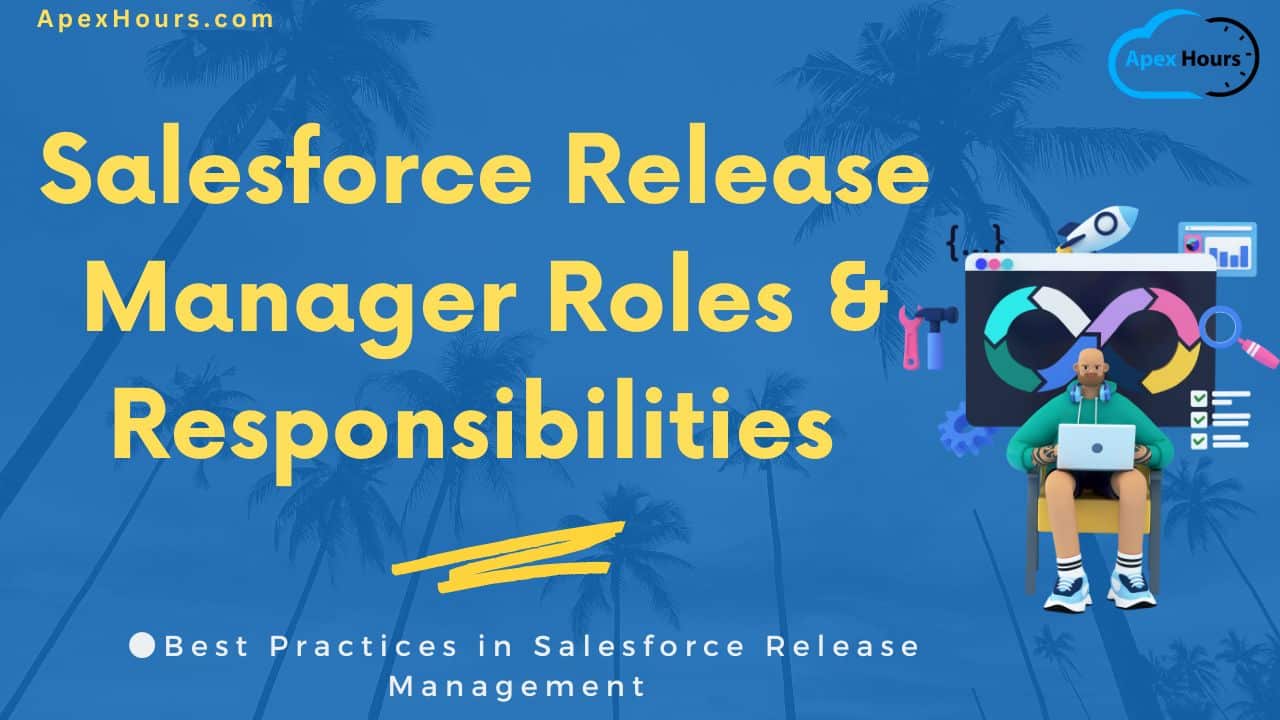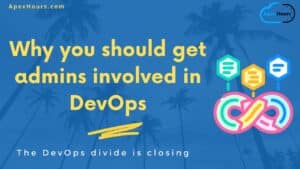The role of a Salesforce Release Manager is crucial in ensuring the smooth and efficient delivery of Salesforce solutions within an organization. The Salesforce Release Manager is a professional responsible for overseeing the planning, coordination, and execution of Salesforce releases within an organization. Join us to learn about Salesforce Release Manager Roles & Responsibilities.
Ensuring the stability of the system is crucial in this role, and it involves delivering new features and improvements to end users. In the realm of Salesforce management, a Release Manager oversees the journey of software developments from inception to production, guaranteeing a smooth, secure, and well-regulated transition for new software, updates, and configuration changes.
What is Salesforce Release Manager?
A Salesforce Release Manager is a professional responsible for overseeing the end-to-end process of releasing changes and updates within the Salesforce platform. Their primary role involves managing the transition of new software, updates, and configuration changes from the development phase through testing and ultimately to the production environment.
The goal is to ensure a smooth, controlled, and successful release process that maintains the stability and integrity of the Salesforce system.

Prerequisites to Become a Salesforce Release Manager
Before moving or looking for any opportunity for a Salesforce Release manager You need to check some prerequisites to apply job start a career or move on this profile. I will give the small key points about the prerequisites. The prerequisites for the role of a Salesforce Release Manager typically include a combination of education, experience, technical skills, and other key qualifications.
1. Experience
Experience working with Salesforce configurations, customizations, and integrations.
2. Salesforce Knowledge
In-depth understanding of Salesforce platform capabilities, features, and limitations.Familiarity with Salesforce development tools, such as Apex and Visualforce.
- Proficiency in version control systems (e.g., Git).
- Experience with CI/CD tools and practices.
- Tools help automate and streamline the process, making it more efficient and less prone to errors.
Experience with Git-based development is significant for a Salesforce Release Manager, as Git is the industry-standard tool for version control. It allows multiple developers to work on the same codebase without overwriting each other’s changes. It also provides a history of changes, making it easy to revert to a previous version if necessary.
3. Certifications
Relevant Salesforce certifications, such as Salesforce Certified Administrator, may be beneficial—Salesforce Certified Platform App Builder (e.g., Certified Administrator, Platform App Builder). In the future, you can go with Salesforce Certified Advanced Administrator & Salesforce Certified Development Lifecycle and Deployment Designer.
4. Understanding of DevOps Tools
For a Salesforce Release Manager, knowing about DevOps principles can make the release process work better. These principles help in using automated processes, keeping an eye on everything, communicating well, and quickly fixing any problems – all of which are very important for a successful Salesforce release.
To effectively manage the Salesforce release process, a release manager should have experience with various DevOps tools that are commonly used with Salesforce. These tools help automate and streamline the process, making it more efficient and less prone to errors.
These tools help automate and streamline the process, making it more efficient and less prone to errors. DevOps Center , Copado , Gearset , AutoRabit & Many Mores.
Check our Salesforce DevOps Guide.
5. Project Management
- Enhance your project management prowess with a focus on Agile and Kanban methodologies.
- Cultivate robust skills for planning, executing, and overseeing projects efficiently.
- Gain a comprehensive understanding of these methodologies to adeptly navigate diverse project landscapes, ensuring successful outcomes and maximizing team productivity.
6. Communication Skills
As a release manager, effective communication is paramount. Sharpen your skills in conveying technical details clearly and fostering smooth interactions. Emphasizes honing excellent communication and interpersonal abilities to streamline coordination between teams, stakeholders, and clients, ensuring seamless project execution and successful releases.
7. Change Management
As a Salesforce release manager, adept change management is crucial.
- Focuses on grasping change management principles and practices to mitigate disruptions during releases.
- Learn strategies to smoothly implement changes, ensuring seamless transitions for users and maximizing the effectiveness of Salesforce deployments.
8. Team Collaboration
As a Salesforce release manager, you’ll need to team up with developers, testers, and operations folks to make sure releases go smoothly.
This means working together, sharing ideas, and coordinating tasks. By collaborating effectively, you can ensure that Salesforce updates are rolled out smoothly and everyone stays on the same page.
9. Adaptability
As a Salesforce release manager, being adaptable is key. You need to be flexible and ready to handle changes in technology and business needs. This means staying open-minded and adjusting quickly to keep up with the ever-changing environment, ensuring successful Salesforce releases despite shifting conditions.
Role & Responsibilities of a Salesforce Release Manager
To effectively manage the Salesforce release process, a release manager should have experience with various DevOps tools that are commonly used with Salesforce. These tools help automate and streamline the process, making it more efficient and less prone to errors. Enterprise implementations of complex SFDC applications, with reports, and workflow, working with several SFDC objects.
The role of a Salesforce Release Manager involves overseeing the end-to-end process of deploying changes, updates, and configurations within the Salesforce platform.
As a Salesforce release manager, your role involves meticulously planning and scheduling the introduction of new features and updates. You also oversee various Salesforce environments, ensuring seamless transitions between them.
By managing these aspects effectively, you ensure a smooth and efficient release process, optimizing the functionality of Salesforce for your organization.
- Release Planning: Plan and schedule the rollout of new features and updates.
- Environment Management: Oversee different Salesforce environments, ensuring smooth transitions.
- Version Control: Implement and maintain version control for tracking changes.
Why Engage Our Salesforce Release Managers: Ensuring Seamless Deployments
Efficient Release Scheduling
Our adept release managers proficiently schedule, coordinate, and oversee the deployment of updates for multiple applications, ensuring a smooth transition without disrupting ongoing operations.
Collaborative Approach
Working hand in hand with your IT teams, our release managers foster collaboration to construct a comprehensive release calendar that aligns with your organization’s objectives and technical requirements.
Mitigating Risks, Maintaining Stability
With a keen focus on risk management, our release managers meticulously navigate the complexities of product releases, safeguarding against potential disruptions while maintaining system stability and reliability.
Project Management Support
Beyond release management, our experts provide invaluable support in project management, particularly in change management, ensuring adherence to project milestones and timelines while accommodating scope adjustments.
At the heart of our service lies the indispensable role of the Salesforce Release Manager, akin to a conductor orchestrating a symphony of updates within your Salesforce ecosystem. They are the guardians of stability, meticulously planning and executing deployments while fostering collaboration and mitigating risks to ensure a seamless experience for your organization
Release Planning & Environment Management
As a Salesforce release manager, your job is to carefully plan and schedule when new features and updates are added. You also make sure that moving between different parts of Salesforce goes smoothly. By doing this well, you help make sure that Salesforce works well for your organization, making things easier and more efficient for everyone using it.
Version Control & Coordination
As a Salesforce release manager, you keep track of all the changes made to Salesforce so everyone knows what’s happening. You work closely with different teams like developers and testers to make sure updates go smoothly.
By working together well, you make sure that changes happen smoothly and that Salesforce works great for your organization
Testing Oversight & Deployment Management
As a Salesforce release manager, you make sure all the new changes are tested properly to find and fix any problems quickly.
You also plan and put into action the updates for Salesforce. This means everything happens smoothly, making sure Salesforce works well for your organization.
Communication & Documentation
As a Salesforce release manager, you’re great at talking to people and keeping them informed about when updates will happen and how things are going.
You also make sure to write down everything about the updates, so everyone knows what’s supposed to happen. This helps everything go smoothly and makes it easier for everyone to make decisions
Governance & Continuous Improvement
As a Salesforce release manager, you make sure that all the rules and security measures are followed to keep Salesforce safe. At the same time, you’re always looking for ways to make things better and faster. You check how things are done and make changes to make sure everything works well and stays safe
Responsibilities of a Salesforce Release Manager
As a Salesforce release manager, you’re in charge of everything related to updates for Salesforce.
You plan when updates happen, work with different teams to make sure they’re ready, and make sure the updates happen smoothly. You also make sure everyone follows the rules to keep Salesforce safe and let everyone know what’s going on. Plus, you’re always trying to make things better and faster, so you keep an eye on how things are going and make changes if needed
Key Responsibilities
As a Salesforce release manager, you are crucial in ensuring that updates and changes to Salesforce happen smoothly and efficiently.
Your main tasks include deciding which updates are the most important, planning when they’ll happen, and estimating how long they’ll take. You work closely with the development team to coordinate these releases and make sure they fit into the overall schedule.
Additionally, you’re responsible for documenting the entire release process. This documentation helps ensure clear communication and provides a record of what changes were made and when they happened.
Overall, your role is essential for keeping Salesforce running smoothly and ensuring that updates happen without causing any disruptions.
What is and why have a Release Calendar?

Automation
Release management tools offer automation features, streamlining repetitive tasks like building, testing, and deploying code, saving valuable time and effort.
Collaboration
Effective tools promote teamwork by facilitating communication and information-sharing among teams, ensuring everyone stays updated throughout the release process.
Release Planning
Tools equipped with features like calendars, timelines, and roadmaps aid in planning and scheduling releases across multiple teams and departments, ensuring smooth coordination.
Deployment
As your release process evolves, deployment management tools become essential for efficiently managing deployments across various environments, enhancing reliability and consistency.
Rollout Management
Modern tools include feature flag capabilities, enabling targeted releases to specific user groups and supporting A/B testing, elevating the sophistication of release management strategies.
Metrics and Analytics
To continually improve processes, your release management toolkit should encompass tools for gathering objective feedback and tracking metrics and analytics, guiding informed decision-making and optimization efforts.
What is a release plan in Agile?
Release planning is a staggered process and is usually planned around every sprint or release milestone activity. The process starts with what is called as initial release planning and leads to product-level planning. In the initial release planning phase, the focus is on solving the customer problems.
How to plan release in Agile?
Agile release planning takes a more practical and dynamic approach. Work is broken down to match feature releases at different life stages of the product
What is agile release planning?
Release planning involves the continuous work and coordination of different team members and stakeholders.
Business teams come up with an initial release plan that solely focuses on customer pain points – this phase can last from a few days up to a couple of months, depending on the size of the market, complexity of the problem, depth of the solution etc.
11 Steps to Create an Effective Release Plan
1. Define Product Vision:
- Figure out what your product aims to achieve.
- Gather input from product folks, business sponsors, and development leads.
- This vision guides your entire release plan.
2. Assess Product Backlog
- Review the list of tasks that need to be done (product backlog).
- Prioritize tasks based on the product vision and team input.
- Create a basic release plan outlining goals and deadlines
3. Organize Release Plan Meeting:
- Bring all stakeholders together to discuss and refine the plan.
- Ensure everyone understands and agrees on the plan.
4. Invite Stakeholder Input:
- Welcome opinions and feedback from all stakeholders.
- Aim for consensus on essential features and release dates.
5. Assess Past Sprints.
- Look at previous projects and their success rates.
- Learn from past mistakes to improve the current release plan
6. Verify Sprint Velocity
- Determine how quickly your team can complete tasks.
- Use data from previous projects to set realistic goals
7. Establish the Definition of Done
- Decide what “done” means for each milestone.
- Set criteria for moving on to the next stage of the plan.
8. Finalize Release Calendar:
- Decide what “done” means for each milestone.
- Set criteria for moving on to the next stage of the plan.
9. Finalize Release Calendar
- Polish the release plan and share it with everyone.
- Make sure everyone knows the deadlines and goals.
10. Create Clear Tasks and Timelines
- Make sure everyone understands their roles and deadlines.
- Provide easy access to the release plan for reference.
11. Prepare Post-Release Plan
- Understand that release planning is ongoing.
- Be ready for the next stage of updates and improvements.
RACI Matrix for Salesforce Release Manager
A RACI matrix for a Salesforce release manager outlines the roles and responsibilities of individuals or groups involved in the release management process. RACI stands for Responsible, Accountable, Consulted, and Informed.
Salesforce release manager RACI
In the context of a Salesforce release manager, this matrix delineates who is responsible for specific tasks, who is accountable for their completion, who needs to be consulted, and who needs to be informed throughout the release process.
This tool helps clarify roles, streamline communication, and ensure accountability for successful Salesforce releases.
- Responsible (R): Individuals or teams responsible for completing specific tasks. This may include:
- Development team: responsible for coding and implementing changes.
- Testing team: responsible for conducting various testing phases.
- Deployment team: responsible for deploying changes to different environments.
- Documentation team: responsible for preparing release documentation.
- Accountable (A): The person ultimately answerable for the completion of the task. This is typically the Salesforce Release Manager who oversees the entire release process and ensures its success. They are accountable for coordinating all activities, resolving issues, and ensuring adherence to timelines.
- Consulted (C): Individuals or groups whose input is sought before making decisions or taking action. This may include:
- Business stakeholders: consulted for requirements gathering and validation.
- Product owners: consulted for feature prioritization and acceptance criteria.
- IT governance team: consulted for compliance and security considerations.
- Informed (I): Individuals or groups who need to be kept informed about progress and decisions but are not directly involved in the execution. This may include:
- Project managers: informed about release timelines and dependencies.
- End-users: informed about upcoming changes and any impact on their workflows.
- Executives: informed about overall release progress and risks.
The key to an efficient RACI matrix is clarity and alignment among all stakeholders regarding their roles and responsibilities.
RACI Matrix
Regular communication and updates ensure everyone stays informed and accountable throughout the Salesforce release process. Adjustments to the RACI matrix may be necessary based on each release’s specific requirements and dynamics.
| Task | Salesforce Release Manager |
| Coordinate Scrum, UAT, and third-party teams | R |
| Ensure teams follow the company’s established policies and procedures. Follow the service release and deployment policy and planning. | A |
| Ensure all data migration has been completed successfully. | R |
| Document outstanding known errors and workarounds. | R |
| Release documentation, communications, and training. | R |
| Implement a source control system. | R |
| Provide a release roadmap. | A |
| Conduct service roll-out planning. | A |
| Manage reports on release progress and service-level agreements (SLAs). | A |
| Ensure release acceptance, including Business sign-off of UAT. | A |
- R (Responsible): The Salesforce Release Manager is responsible for tasks directly related to coordinating, documenting, and ensuring the successful execution of the release process.
- A (Accountable): The Salesforce Release Manager is accountable for overall release planning, progress management, and ensuring alignment with company policies and standards.
Since this matrix focuses only on the Salesforce Release Manager’s responsibilities, there are no entries for Consulted (C) or Informed (I). These roles may be filled by other stakeholders outside the scope of the Salesforce Release Manager.
In a RACI matrix, while Responsible (R) and Accountable (A) are typically the primary focus, Consulted (C) and Informed (I) roles are also crucial for effective communication and collaboration.
Here’s why Consulted (C) and Informed (I) roles may not be explicitly defined for the Salesforce Release Manager:
- Scope and Accountability: The Salesforce Release Manager is primarily responsible for orchestrating the release process, making decisions, and ensuring successful outcomes. While they may consult with others or inform stakeholders as needed, their primary focus is on direct involvement and accountability for execution.
- Task-specific Focus: The tasks listed in the matrix are often operational or managerial in nature, requiring direct action or oversight from the Release Manager. Consulted (C) and Informed (I) roles may be more relevant for tasks involving consultation with subject matter experts, stakeholders, or providing updates to broader teams, which may not be explicitly outlined in this matrix.
- Clarity and Simplicity: For clarity and simplicity, especially in a table format, the matrix may focus primarily on the most critical roles (Responsible and Accountable) directly related to the Salesforce Release Manager’s responsibilities. This helps ensure clear delineation of roles without overwhelming the matrix with additional roles.
While Consulted (C) and Informed (I) roles are undoubtedly important in the overall release process, they may be addressed separately or implied within the broader context of communication and collaboration within the release team, rather than explicitly outlined for every task in a RACI matrix specifically tailored to the Salesforce Release Manager’s responsibilities.
Best Practices in Salesforce Release Management
Some key best practices include:
- Establish Clear Release Processes: Define clear and documented release processes tailored to your organization’s needs, including version control, testing procedures, and deployment strategies.
- Utilize Sandbox Environments: Leverage Salesforce sandbox environments for development, testing, and staging to ensure changes are thoroughly vetted before deployment to production.
- Implement Change Management: Enforce change management practices to track and manage all changes made to the Salesforce org, ensuring transparency, accountability, and compliance with regulatory requirements.
- Automate Deployment Processes: Automate deployment processes using tools like Salesforce DX, Ant Migration Tool, or third-party CI/CD solutions to streamline and standardize deployments while reducing manual errors.
- Coordinate Cross-Functional Teams: Collaborate closely with development, testing, operations, and business stakeholders to coordinate release activities, communicate status updates, and address any issues or dependencies.
- Perform Thorough Testing: Conduct comprehensive testing, including unit testing, integration testing, user acceptance testing (UAT), and regression testing, to validate changes and minimize the risk of defects in production.
- Schedule Releases During Low-Impact Times: Schedule releases during low-traffic periods to minimize disruption to users and business operations, and communicate release schedules in advance to stakeholders.
- Monitor Release Performance: Monitor release performance metrics, such as deployment success rate, error rates, and user feedback, to identify areas for improvement and ensure continuous optimization of release processes.
- Document Release Activities: Maintain detailed documentation of release plans, configurations, and post-deployment activities to facilitate knowledge sharing, compliance audits, and troubleshooting.
- Continuously Improve Processes: Regularly review and refine release management processes based on lessons learned, feedback from stakeholders, and evolving business requirements to drive continuous improvement and efficiency.
By following these best practices, Salesforce release managers can effectively manage the release lifecycle, mitigate risks, and maximize the value of Salesforce deployments for their organizations.






Please do update the latest update on RM